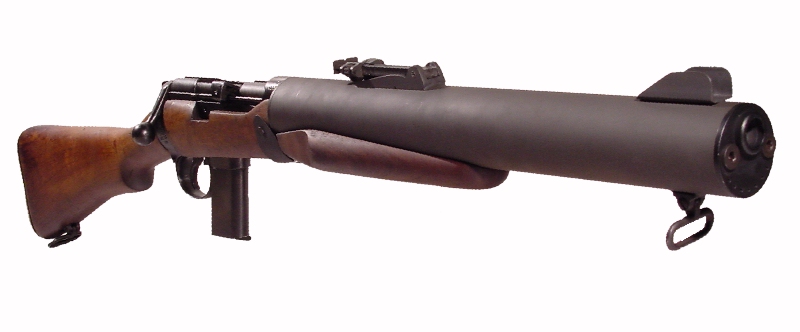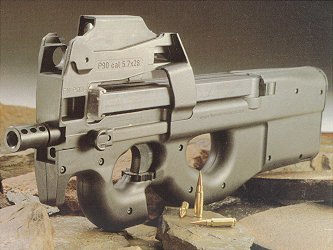
Friday, November 23, 2007
Sola Super
From 1954-1957, during a time when the World markets had a glut of SMG's, the Sola Super was made in Luxembourg by Societe Luxembourgoise d'Armes SA of Ettelbruck, None the less, it did get some sales in South America and Africa. It was a simple but well-made weapon that shot 9x19mm Parabellum. It used the same magazine of an MP-40 and its stock resembles the M3's. 

FP-45 Liberator
The FP-45 Liberator was made during WWII for use by the Resistance in Europe and the Far East, although mainly used in China and the Philippines. The Liberator was produced by the Inland Guide Lamp Manufacturing Division of the General Motors Corporation, being made from June of 1942 to August of the same year. Over 1,000,000 were made during this time at a rate of approximately one per six seconds, thus becoming the only known weapon to take longer to load than to make, since it took ten seconds to load. To hide the fact that it was being mass produced, it was named Flare Projector Caliber .45 (FP-45).


Saturday, November 17, 2007
De Lisle Carbine
This weapon was designed in 1943 by William G. de Lisle and Sir Malcolm Campbell. The de Lisle Carbine is simply an S.M.L.E. with the barrel of a Thompson SMG and the magazine of a Colt M1911 and, of course, the silencer made specifically for this weapon. The combination of the superb silencer and the sub-sonic ammunition make this weapon one of the most silenced guns ever made. It was designed to be used by the British Special Operations Executive (SOE) during WWII. Also it was used in the Malay Emergency, Korean Conflict, and Northern Ireland. There are claims of it being used in more recent conflicts, but these claims have not been substantiated. 

Saturday, November 3, 2007
F.B. Radom VIS wz.35

In the early 1930's, the newly formed Polish Army was in need of a standard combat pistol to replace Ng 30, a licensed-built Nagant M1895 revolver built by Radom, which by this time was somewhat elderly. To fill this need, the Polish Army advertised a combat pistol competition in which many different entries were submitted including ones by Breda, Skoda, Mauser and two Polish engineers named Wilnewczyc and Skrzypinski.Trials were held in 1935. The result was a draw between the Skoda and Polish designs and, being patriotic, the adjudicators selected the Polish model. Further trials followed, and in 1936, it was put into production as the VIS-35 at Radom.
The VIS-35 used a modified Browning design which had the usual locking lugs on the barrel mating with grooves in the slide. It used a shaped cam similar to that used on the Browning HP-35. Another design change was the use of a recoil spring rod under the barrel replacing the barrel bushing of the colt design. A grip safety was fitted, although there was no manual safety catch. Instead, it used a hammer release catch on the left rear of the slide which, after being pressed , retracted the firing pin into its housing and then tripping the sear allowing the hammer to fall on a loaded chamber in safety. The pistol weighs 37 ounces empty, plus its bulk makes it one of the most comfortable 9mm Parabellum pistols to shoot.
Original Radom production for the Polish army was extremely well made and finished. It can be recognized by a Polish eagle on the left of the side and with the inscription 'FB Radom VIS wz 35', with the year of manufacture and the Patent Number 15567. Production under German control was of a lower standard, and as the war went on, continued to degrade. Also under German control, some design changes took place, including getting rid of the hammer release. Another change was the grips which were originally made out of black plastic with
 'FB' on the left side and 'VIS' on the right. These were abandoned in 1943 for plain wooden grips. Markings were also changed, no longer having the Polish eagle but the German eagle and German Fremdengerat Number 'P35(p).
'FB' on the left side and 'VIS' on the right. These were abandoned in 1943 for plain wooden grips. Markings were also changed, no longer having the Polish eagle but the German eagle and German Fremdengerat Number 'P35(p).Production ended in 1944 when the Soviet army took Radom, and the factory was wrecked in battle. The pistol was put back in production in 1997 by Radom and can only be recognized by year of production and a better finish.

Thursday, October 11, 2007
FN P90

Fabriqeu Nationale P90 began as the Project 9.0 in response to NATO's call for a personnel defense weapon (PDW) which would better equip tank crews, artillery crews, etc., whose duty would not include the use of a full-size weapon. As part of the NATO requirement.
 The P90 is built around the 5.7x28mm ammunition which was developed specifically for this gun. The cartridge is unique because, after penetrating a body, it tumbles end-over-end so that it causes a larger wound. Also, the military and law enforcement variant can penetrate most modern body armor.
The P90 is built around the 5.7x28mm ammunition which was developed specifically for this gun. The cartridge is unique because, after penetrating a body, it tumbles end-over-end so that it causes a larger wound. Also, the military and law enforcement variant can penetrate most modern body armor.The P90 is blowback operated and fires from a closed bolt.
The magazine lies above the barrel and holds up to 50 ballets in two rows in horizontal position pointing to the left.

Thursday, October 4, 2007
FN SCAR
The SOF Combat Assault Rifle, or SCAR, is a modular rifle made by Fabriqeu Nationale de Herstral (FNH) for the U.S. Special Operations Command (SOCOM) to satisfy the requirements of the SCAR competition. SCAR is a family of rifles with two main types.The SCAR-L (light) which is chambered for 5.56mm NATO cartridge and the SCAR-H (heavy) which fires 7.62mm NATO ammunition.

Both can be configured into either sniper variant (SV) or CQC (Close Quarter Combat). There is also a single-shot 40mm grenade launcher, EGLM(Enhanced Grenade Launcher Module), which was thrown in at the last minute. Introduced in 2004 as an addition, the EGLM was originally developed for the FN F2000 assault rifle. The EGLM allows the shooter to launch grenades with the middle finger so as not to interfere with the magazine.

Subscribe to:
Comments (Atom)